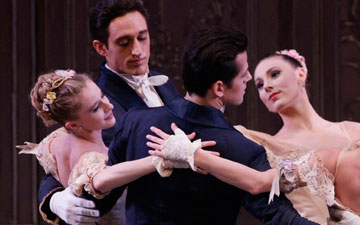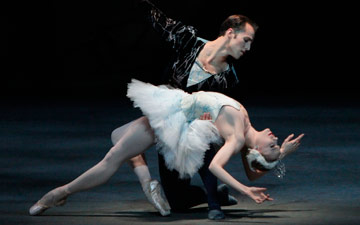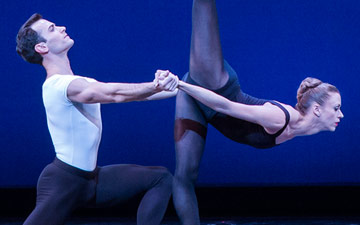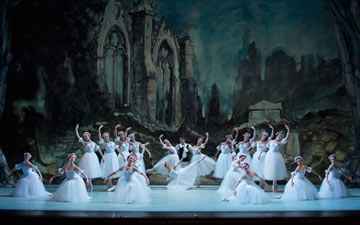
© Paul Kolnik. (Click image for larger version)
New York City Ballet
Prodigal Son, Liebeslieder Walzer
★★★✰✰
New York, David H. Koch Theater
2 March 2019
www.nycballet.com
davidhkochtheater.com
Into the Future
Changes are afoot as the winter season wraps up at New York City Ballet, and not a moment too soon. A few days ago, new management was announced, a year after Peter Martins’s departure under a cloud of nasty allegations. A member of the quartet of interim managers, Jonathan Stafford, will stay on as Artistic Director. In interviews, he has said he’ll manage the staffing and day to day issues. In addition, a new position, Associate Artistic Director, has been created for the former New York City Ballet star Wendy Whelan, who retired in 2014; she’ll focus on commissioning new works, coaching, teaching. The house choreographer, Justin Peck, more in demand every day, will stay on as artistic advisor, but retire from dancing after the Spring season.
Many questions remain. Will Whelan and Stafford collaborate in casting? Will City Ballet continue to perform works by Martins, and if so, will he be involved in coaching and casting them, as is customary for choreographers? There was some controversy recently when he came in to rehearse his Sleeping Beauty and made changes to the casting. Will issues be raised over the casting of Stafford’s sister and wife, both members of the company? There is still an infinitude of details to be ironed out. But without question, this is a step forward. Whelan is a well-respected figure in the dance world; she’s kind, she’s serious, and she has collaborated with a number of prominent choreographers, from Lucinda Childs to Alexei Ratmansky to Christopher Wheeldon and Kyle Abraham. They all admire her greatly. There are reasons for hope.
The stakes couldn’t be higher. New York City Ballet is the repository of one of the greatest repertories in ballet: the works of George Balanchine and Jerome Robbins. With such riches comes an enormous responsibility. The ballets need more than just stewardship; a change of management is an opportunity to take a new look, to fix what isn’t working and perhaps go back to the source. Why not invite in dancers who worked directly with Balanchine and Robbins to fine-tune the details? A few, including Edward Villella and Baryshnikov have already been invited, but it doesn’t seem like a systematic effort. Why not perform a wider swath of Balanchine and Robbins ballets instead of the same ones over and over? Why not spread them across the season rather than package them together like museum pieces?

© Paul Kolnik. (Click image for larger version)
One of the season’s final programs, a double header of Prodigal Son and Liebeslieder Walzer, shows just how important such decisions will be. Prodigal is an essential part of the repertory; it’s one of two works from Balanchine’s Ballets Russes years (the 20’s) that are still performed, a time capsule of Balanchine’s early expressionist leanings. These days it’s mainly seen as a vehicle for a few leading male dancers. And despite good performances by the leads, like today’s cast of Daniel Ulbricht and Teresa Reichlen (a wonderfully icy siren), the ballet feels shrouded by a veil of habit, and not nearly as exciting as it should be. Edward Villella was recently brought in to work with the principal men – good! – but the whole ballet needs to have its angles sharpened.
On the other hand, a trend I’ve been happy to see is the introduction of new casts to familiar works. Today’s Liebeslieder (1960) was a case in point. Five of its eight dancers were new to their roles. And it worked; the performance had poetry and resonance. Perhaps because some of the dancers were new, their emotions were right on the surface. This is one of the most precious of all Balanchine’s ballets; within its fifty-minute span it seems to contain a world of emotion, both profound and infinitely civilized.
Four couples dance and converse in an elegant room lined with large doors opening onto an invisible garden. A quartet of singers and two pianists, playing four hands, perform Brahms’ two Liebeslieder song cycles, Opus 52 and 65 onstage. They wear the same satin dresses and tails as the dancers. (Note to the new régime: the level of the singing could be a lot higher.) The songs set the tone; the dancers respond to the music and texts, revealing secrets. What may at first look like a period piece quickly turns into a quiet unspooling of private dramas. At the end, the dancers sit, listening to the music, lost in its world, along with the audience.

© Paul Kolnik. (Click image for larger version)
In the first section, the women wear heeled shoes, and the dancing is more earthbound. And this earthbound quality opens the way to moments of incredible intimacy. A man lightly pushes his partner forward by the shoulders, and she falls into a deep lunge, then rests against his shoulder as he traces a circle, completing the line of her other arm with his own. Later in the same duet, he revolves around her like a planet circling the sun. In another duet, a man whispers into his partner’s ear, again and again, and she blushes and falters. Another man places the back of his hands against his partner’s temples, as if checking her temperature; when she swoons, he picks her up in his arms and she lies flat in the air, like a corpse. The image takes your breath away. Each of the women – and it is a ballet mainly about women – experiences loneliness, loss, reconciliation, forgiveness.
In the second half, the ballroom is empty, with the doors open to the evening sky. The dancers enter and exit in couples. The women are now on pointe and the men have removed their white gloves. The feeling is less intimate and the dancing more classical. Still, we see echoes of the first half, a swoon there, a whispered secret, a kiss on the hand, dancers revolving like planets in orbit. Toward the end, a man lifts a woman and carries her backward through space; she looks as if she were floating through time.

© Paul Kolnik. (Click image for larger version)
At the Saturday matinee, the woman floating through the air was Sara Mearns. She isn’t new to this ballet and brings to it her usual rapt intensity and a touch of wildness. In a trio halfway through he first section, she danced recklessly, and for a moment, the air of civility was almost broken. Russell Janzen partnered her delicately, eloquently, with the very ends of his long fingers, approaching her almost with a sense of wonder. Unity Phelan, new to the ballet, danced it as if in a dream; her partner was Taylor Stanley, who was also débuting. It was an interesting pairing. Stanley matched the beauty of Phelan’s port de bras, the curve of her fingers. Tiler Peck, dancing the role originated by Violette Verdy, hinted at loneliness and a touch of despair as she swooned once, and then again, in her partner’s arms. She was the most theatrical dancer in the cast, with a clear character in mind. Her partner, Joseph Gordon, looked a little undercooked next to her. Only the fourth couple, Abi Stafford and Daniel Applebaum lacked a particular ambiance. (Both were débuting.)
The poetry of a ballet like Liebeslieder is a delicate, a precious thing. It is a world. And that world is now in the hands of a new generation of leaders. May it continue to live under their care.

















You must be logged in to post a comment.